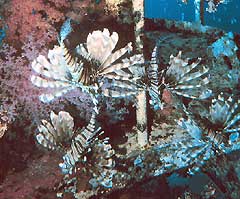Habitat
Lionfish
...on rocky bottom ...in sea grass


...near a shipwreck

Description:
They prefer to live near mangroves, sea grass, coral, pilings, shipwrecks, or even on hard rocky bottom. They live on or close to the ocean floor at depths that range from 1 to 1000 feet deep.
Temperature: 10.0 degrees Celsius – 16.0 degrees Celsius
Salinity Range: 30-36ppt
Native Range:
These habitats are found on coastlines all over the Pacific and Indian Oceans where, Pterois miles, and its closest genetic relative Pterois volitan, occupy a significant amount of coastline. The two share habitats along Asia’s southern coastline, but the Pterois miles is more commonly found further west. Pterois volitan are found as far north as Japan’s southern coast and as far south as Australia’s north and western coastline. It is found as far west as Papua New Guinea, as far east as the Indonesian Islands, and along the Indochina Peninsula. Pterois miles native range extends from the Indochina Peninsula to India and continues along the coast as north as, the Red Sea. From there its range extends down the African coastline to African’s southern tip.
This map shows the native range of both P.miles and P.volitans, as well as the invasive range in the Atlantic Ocean.
This map was created by NAS (Non-indigenous Aquatic Species.) To view a larger version of the map or visit where the original is located, click on the map.
Invasive Range:
Until recently, Lionfish were only found in their native range, but in 1985 an adult male lionfish was found swimming off the coast of Florida! Many have speculated but no one knows exactly how a lionfish was spotted thousands of miles away from its closest native region. Many believe that aquarium lionfish were released into the ocean or, diving tour guides have been releasing them so that they can show them off to their clients. Since 2002, invasive lionfish have been spotted as north as New York and inhabit almost every coastline of the Gulf of Mexico and Caribbean Sea. Sightings have increased in frequency and scientists are predicting lionfish to continue down the coast of South America within the next couple of years. Lionfish in the Atlantic are mostly Pterois volitan but Pterois miles sightings are not uncommon.
Watch this animated map to show the spread of lionfish in the Atlantic. As you can see, the spread of lionfish throughout the Atlantic Ocean and Gulf of Mexico happened extremely fast, indicating that both P.miles and P.volitans have been extremely successful in reproducing.
This map was also created by NAS. To view a larger version of the map or visit where the original is located click on the map.
To read about the specific adaptations that enable it to occupy such a wide range of habitats all over the world, click on the Adaptations button.


